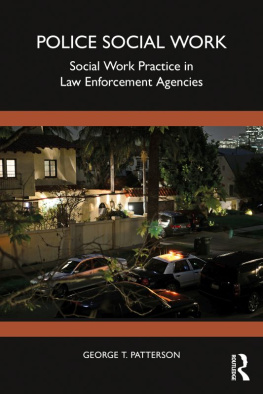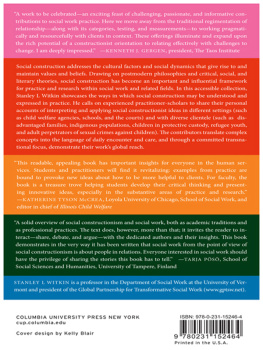CONTENTS

POLICE SOCIAL WORK
Grounded in contemporary social work practice approaches such as trauma-informed practice, cultural competency, and systems theory, this book provides a model for developing, implementing, and evaluating police social work and social service collaboration within the context of contemporary policing strategies.
The practice of professional social work in law enforcement agencies is increasingly becoming an important area of practice. Police social work, as it is known, benefits community residents and assists law enforcement agencies with accomplishing community policing and other problem-solving initiatives. Throughout 13 chapters, this book covers:
The practice of professional social work within law enforcement agencies
The types of social problems addressed and characteristics of police social work collaborations
Ethical and other practice issues that arise when collaborating with law enforcement agencies and required practice skills to address these issues
An examination of collaborations formed between law enforcement agencies and social services agencies in which the service providers are not professional social workers
A model for developing police social work collaborations and investigating collaboration effectiveness
Expanded roles for police social work practice such as consultation, officer selection, training recruits and police officers, and assisting their families
Police Social Work provides a wealth of case studies and other reference material to prepare students for police social work practice, as well as serving as a resource for police officers, recruits, and students majoring in policing.
George T. Patterson is Associate Professor in the Silberman School of Social Work at Hunter College, City University of New York. A certified police instructor and police social worker, Dr. Patterson has served as a visiting professor and curriculum advisor in several law enforcement training academies, trained police officers and recruits, and teaches criminal justice courses to social work students. He has published on the topics of police social work, the stress of police work, and coping among police officers and recruits. His written testimony is included in the May 2015 Final Report of the Task Force on 21st Century Policing established by President Barack Obama, and his research results are included in An Evidence-Assessment of the Recommendations of the Presidents Task Force on 21st Century Policing.
Cover image: Getty Images
First published 2022
by Routledge
2 Park Square, Milton Park, Abingdon, Oxon OX14 4RN
and by Routledge
605 Third Avenue, New York, NY 10158
Routledge is an imprint of the Taylor & Francis Group, an informa business
2022 George T. Patterson
The right of George T. Patterson to be identified as author of this work has been asserted in accordance with sections 77 and 78 of the Copyright, Designs and Patents Act 1988.
All rights reserved. No part of this book may be reprinted or reproduced or utilised in any form or by any electronic, mechanical, or other means, now known or hereafter invented, including photocopying and recording, or in any information storage or retrieval system, without permission in writing from the publishers.
Trademark notice: Product or corporate names may be trademarks or registered trademarks, and are used only for identification and explanation without intent to infringe.
British Library Cataloguing-in-Publication Data
A catalogue record for this book is available from the British Library
Library of Congress Cataloging-in-Publication Data
A catalog record has been requested for this book
ISBN: 978-0-367-67663-6 (hbk)
ISBN: 978-0-367-67657-5 (pbk)
ISBN: 978-1-003-13225-7 (ebk)
DOI: 10.4324/9781003132257
Typeset in Bembo
by KnowledgeWorks Global Ltd.
To My Parents
FIGURES
TABLES
A NOTE ABOUT THE BOOK COVER
Observing police vehicles parked in neighborhoods is not an uncommon sight. Most have seen police officers parked in marked police vehicles speaking to one another in parking lots or other spaces. Some can even identify an unmarked police vehicle parked in a neighborhood. This book cover image was selected because throughout my police social work experience, I drove an unmarked police vehicle during my shift as I responded to calls for service. Many times as a police social worker, I would meet with officers in the unmarked police vehicle to share a case outcome, to discuss other issues, or provide technical assistance to a police officer. Social work assessment, knowledge, skills, and consultation are adaptable to a range of settings.
PREFACE
This book was inspired by my professional police social work practice experience. My primary experience involved employment in a law enforcement agency providing police social work services in an urban community responding to a wide range of social problems, crises, and emergencies that came to the attention of law enforcement. My experience is perhaps atypical because I drove an unmarked police vehicle. I was dispatched to the scene by the 911 dispatcher during my tour of duty to meet with police officers and other first responders who were already on scene to provide crisis intervention to community residents.
In addition to my primary experience, I trained recruits and police officers to provide social service-related services. I also provided stress management interventions to recruits and police officers focused on stress and traumatic stress, and coping strategies.
Situating my experience as a police social worker in a law enforcement agency which is a host setting has informed me that community residents rely on law enforcement agencies to provide emergency services, particularly those with repeat calls for police services. Unfortunately, the unit where I acquired my police social work experience no longer exists. While the unit has recently changed and no longer performs its former functions, I have learned much from my professional police social work experience:
More training and resources are needed to prepare police social workers for practice.
Law enforcement responds to a wide range of social problems that are social service-related and involve non-crime situations.
Even when responding to crime situations such as mass shootings, victims and survivors are in need of law enforcement services, some of which are also social service-related.
Social problems that are addressed by law enforcement demonstrate the need for mobile, 24 hours, 7 days a week emergency crisis services in communities.
The objectives of this book are to provide a resource for police social workers, social workers collaborating with police, and social service workers who collaborate with the police. A vast amount of published materials are available that inform police social work practice. However, these materials are inaccessible without the ability to locate and retrieve the materials from databases or other sources.
At the same time that I support professional police social work practice, I also acknowledge the concerns and scrutiny expressed by some in the social work profession regarding the suitability of social work employment and collaboration with law enforcement. Social work concerns often focus on social work employment in law enforcement agencies and collaboration with an occupation that is associated with social control and social injustices such as racial profiling and excessive use of force.








